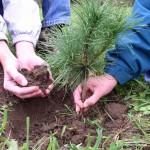If you are thinking of planting trees, fall is the time to start planning for that project. The Wisconsin Department of Natural Resources (DNR) and private tree nurseries start taking orders in the fall (and specifically October for the DNR) for the spring planting season, and they do sell out. More details on how to order are at the end of this blog, but let’s talk about what you want to order first. There are two main factors to consider when deciding what trees you want to plant: site conditions and your goals.
If you are thinking of planting trees in 2012, now is the time to start planning for that project. The Wisconsin Department of Natural Resources (DNR) and private tree nurseries start taking orders in the fall (and specifically October for the DNR) for the spring 2012 planting season, and they do sell out.More details on how to order are at the end of this blog, but let’s talk about what you want to order first. There are two main factors to consider when deciding what trees you want to plant: site conditions and your goals.
Start by answering the question, what do I want to get out of the area I am planting? Do I want privacy around my home? Am I hoping to attract a specific wildlife species? Is my long-term goal to get some income from a timber sale? Do I want to improve the scenic beauty of a particular area? You may desire one or all of these goals, and the trees you choose to plant may have the characteristics to meet one or all of these goals. For example, you may want flowering trees for scenic beauty, but they may also be good for attracting certain birds. Your goals may lead you to plant one species or a variety of species and arrange them in either rows or a random/scattered pattern.
Unfortunately, site characteristics may limit your options as to what you can plant. It is better to acknowledge that up front than to invest money into something that ultimately won’t survive or will have limited growth. Here are a few important factors to consider, and it is best to work with a forester to make sure you get the right trees to meet your goals.
- Climate Conditions – The climate in Wisconsin allows for the growth of a large variety of species across the state, but there is some north/south variability in what can grow where. Winter temperatures, frost timing and precipitation tend to be the main limiting factors in climate. Although many people want to plant black walnut, the high value trees will only grow to their potential in the southern part of the state. On the other end, black spruce does better in the northern half of the state.
- Soil Conditions – You can find your soil type on maps provided by the Natural Resources Conservation Service (NRCS at their local office or online. You can have your soil fertility checked through a soil test at your local UW-Extension office. The soil type impacts the moisture content of soil. Some trees prefer well-drained soils (sandy), while others prefer moist soils (clays). And some trees prefer fertile soils, while others can take advantage of nutrient poor soils. Black spruce prefers very moist soils, which is reflected in their presence in wetland boggy areas. On the other hand, ninebark does well on very dry soils.
- Forest Health Conditions – Be aware of forest health concerns in the area of your woodlands. Insects and disease are a natural part of the ecosystem, but some of these make it difficult to establish particular species. In the central part of the state (and some southern counties), annosum root rot (a disease) affects red, white and jack pine and white spruce. Those may not be the best species to plant if surrounding properties have been affected. Checking with a forester prior to ordering will help identify those problems in your county.
Here are some examples that may help illustrate this process. 1) Your land is in the northwestern part of the state and you are interested in planting a field between your house and the road. So you would like privacy, but also some trees with color or flowers. You may want to plant some northern white cedar as a living fence that remains green year round (of course, you’ll have to do some hunting to keep the deer away). Then you may want to add some faster growing flowering trees between the cedar and the house such as dogwood. 2) Your land is in the northcentral part of the state, and you want to plant an old agricultural field for timber production and to encourage the existing turkey population. You may want to consider a mix of oak and pine plantings.
There are other steps in the planning process that could and should be addressed the fall before planting. For example, now is a great time to prepare the site by removing competing vegetation. Check out our publication “Creating A Forest” for more information. You can also check out the DNR nursery site for a customizable planting plan, and find an order form for trees.
